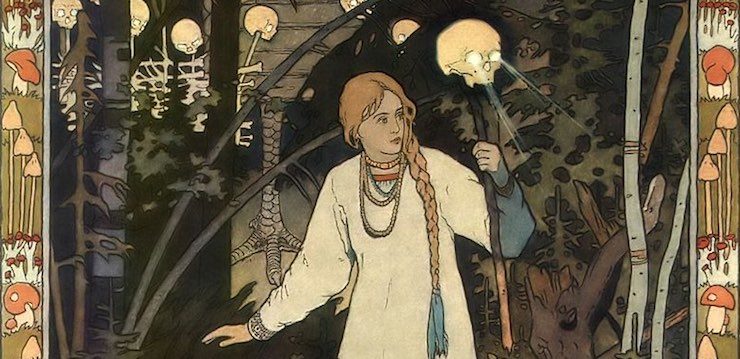Is there anything as fun as a good fairy tale adaptation? Those stories have been passed from hearth to hearth, from page to Disney movie for a reason after all: they give us deep truths about human nature and history. What’s even better than a simple retelling of an old tale, however, is an update on the story. We love it when these stories are told from new angles, or put in conversation with real-world events.
One of the richest vein of folklore can be found in Russian and Slavic mythology, with its dark stories of rusalka, Baba Yaga, and Vasilisa. And because Russian history is so varied (and often tragic), there are practically limitless options to update these classic tales—set against the backdrop of medieval Rus’, the Bolshevik Revolution, or the Soviet Union. I’ve gathered 7 of our favorite Russian-inspired stories below. Be sure to add your own favorites in the comments!
Vassa in the Night by Sarah Porter
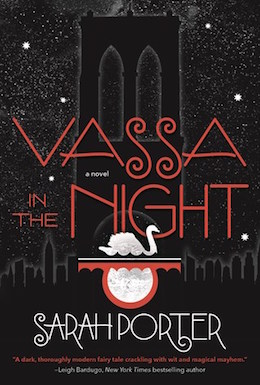 Portions of the classic Russian tale of Vasilisa the Beautiful will be familiar to fans of Cinderella: there is a virtuous child left motherless, a wicked stepmother and stepsisters, and an absent father who leaves his daughter helpless. But when young Vasilisa is sent out for coal for the fire, the story veers in a darker direction. The stepmother and sisters believe they’re sending Vasilisa to her death, and are glad to be rid of her. Instead, aided by the enchanted doll her mother gave her, Vasilisa survives an encounter with Baba Yaga. Depending on the version of the tale, the stepmother and sisters meet an awful fate, and Vasilisa herself often ends the story happily married to the Tsar.
Portions of the classic Russian tale of Vasilisa the Beautiful will be familiar to fans of Cinderella: there is a virtuous child left motherless, a wicked stepmother and stepsisters, and an absent father who leaves his daughter helpless. But when young Vasilisa is sent out for coal for the fire, the story veers in a darker direction. The stepmother and sisters believe they’re sending Vasilisa to her death, and are glad to be rid of her. Instead, aided by the enchanted doll her mother gave her, Vasilisa survives an encounter with Baba Yaga. Depending on the version of the tale, the stepmother and sisters meet an awful fate, and Vasilisa herself often ends the story happily married to the Tsar.
In Sarah Porter’s Vassa in the Night, the action is shifted to the enchanted kingdom of Brooklyn, where most neighborhoods are filled with beautiful people doing beautiful things—usually at loft parties or rooftop bars. Vassa’s Brooklyn neighborhood is different though: she lives under the shadow of Babs Yagg, the angry owner of the corner bodega. Magic abounds in this corner of New York, and Babs Yagg is not above beheading shoplifters, and even honest folk, if they anger her. When Vassa’s stepsister sends her out on an errand, everyone knows it might be the girl’s last night on earth. But Vassa has Erg, a bitchy enchanted doll who intends to use all of its magic to help the girl make it through a treacherous night in Brooklyn.
Deathless by Catherynne Valente
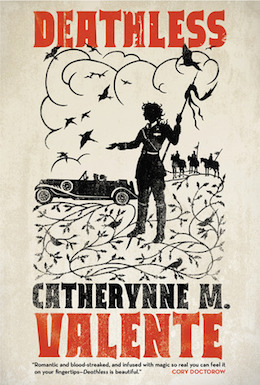 In Slavic folklore, Marya Morevna is the kidnapped wife of the hero Ivan Tsarevich; her kidnapper, Koschei the Deathless is a horrifying skeletal ghoul whose soul is hidden away, making him practically immortal. Koschei has been used as a bogeyman for years, and frightened children root for brave Ivan to rescue Marya. But Catherynne Valente asks: what if Koschei wasn’t so bad, and Marya truly loved him?
In Slavic folklore, Marya Morevna is the kidnapped wife of the hero Ivan Tsarevich; her kidnapper, Koschei the Deathless is a horrifying skeletal ghoul whose soul is hidden away, making him practically immortal. Koschei has been used as a bogeyman for years, and frightened children root for brave Ivan to rescue Marya. But Catherynne Valente asks: what if Koschei wasn’t so bad, and Marya truly loved him?
Valente sets her tale in 20th century Russia: once part of a loving and thriving family, Marya watches helplessly as the Russian Revolution changes her world. She escapes into a dark world of magic when she marries Koschei the Deathless. But as Marya tries to carve out a space for herself within her chaotic marriage, her old world seeps back in; Baba Yaga is transformed into Comrade Yaga, demons have to learn to live under Stalin’s regime, and house imps form committees to bureaucratize their own magic. And as the story unfolds, and war breaks out, all of Russian magic will need to contend with the starvation and bitter cold of the all-too-real blockade of Leningrad in 1942.
The Rusalka Trilogy by C.J. Cherryh
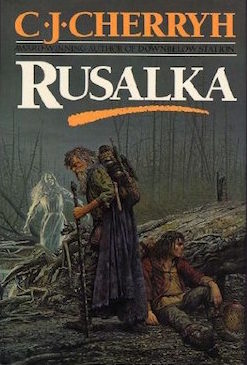 Also known as the Russian series, Cherryh’s story takes place in an alternate medieval Rus’, along the banks of the Dnieper River. The series draws heavily on Slavic folklore, referencing figures from the dark god Chernobog to lesser sprites and fairies—the bannik, leshy and vodyanoy. The first book concerns the fate of a girl who has drowned and become a rusalka—a vengeful water spirit. The girl’s father, a wizard, enlists two young men to help him find and rescue her from Chernevog, his former student who has turned to dark magic.
Also known as the Russian series, Cherryh’s story takes place in an alternate medieval Rus’, along the banks of the Dnieper River. The series draws heavily on Slavic folklore, referencing figures from the dark god Chernobog to lesser sprites and fairies—the bannik, leshy and vodyanoy. The first book concerns the fate of a girl who has drowned and become a rusalka—a vengeful water spirit. The girl’s father, a wizard, enlists two young men to help him find and rescue her from Chernevog, his former student who has turned to dark magic.
The trilogy—Rusalka, Chernevog, and Yvgenie—cover about twenty years as Pyetr, the young wizard Sasha, and various others band together to fight Chernevog. Cherryh’s complicated wish-magic system sets the series apart from other fantasy sagas; wizards are presented as especially dangerous in these novels because even their most casual desires, if expressed, may set into action a course of events with unpredictable outcomes.
The Chaos by Nalo Hopkinson
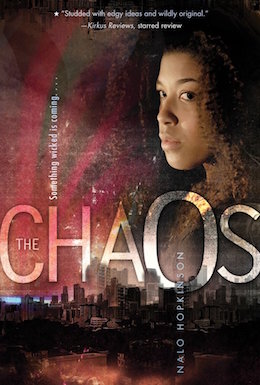 Nalo Hopkinson’s The Chaos takes place in a seemingly normal Toronto that is transformed when a volcano sprouts out of Lake Ontario, unleashing characters from all of the world’s mythology. 16-year-old Scotch already has to float between worlds—she has to play one role at home, a different role at school, and navigate her mixed-race heritage, all while hiding her rebellious streak from her parents and supporting her older brother, who faces more overt racism than she does because of his darker skin.
Nalo Hopkinson’s The Chaos takes place in a seemingly normal Toronto that is transformed when a volcano sprouts out of Lake Ontario, unleashing characters from all of the world’s mythology. 16-year-old Scotch already has to float between worlds—she has to play one role at home, a different role at school, and navigate her mixed-race heritage, all while hiding her rebellious streak from her parents and supporting her older brother, who faces more overt racism than she does because of his darker skin.
The Chaos features appearances from Br’er Rabbit, the Sasquatch, phoenixes, and Anansi—but most terrifying of all may be Scotch’s encounter with Baba Yaga:
…an enormous clawed foot crashed onto the sidewalk, a few feet from where I’m standing. It looked like I imagined a dinosaur’s foot would. I yelped. A second foot crashed down on the other side of me. People were scattering, cars and bicycles swerved out of the way. The feet were attached to ginormous drumsticks, which were attached to ginormouser thighs, all covered in big red and black feathers … I ran, screaming, out from under it. The house thing ran too, continuing its tromp northward up University Avenue, careening every so often against one of the big bronze statues of old, dead white guys they had in the narrow paved strips that ran down the middle of the wide avenue.
The Grisha Trilogy Series by Leigh Bardugo
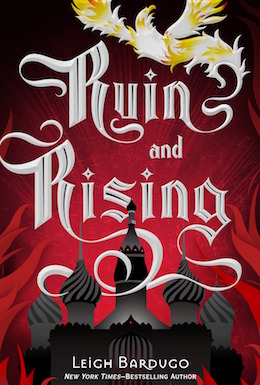 Leigh Bardugo’s Grishaverse gives us a fantastical version of Russia; Ravka is rich in both art and money, and the nation has become the economic hub of the world. It also plays host to a tangled web of underground criminals, and a magical elite called the Grisha. Alina Starkov is an orphan girl serving her country in Ravka’s army, fighting beside her best friend, Mal. When her unit is attacked by dark creatures, she discovers a magical skill she never knew she had. Recruited to the Grisha, she must choose between light and dark magics, her love of her homeland, and the love of her life.
Leigh Bardugo’s Grishaverse gives us a fantastical version of Russia; Ravka is rich in both art and money, and the nation has become the economic hub of the world. It also plays host to a tangled web of underground criminals, and a magical elite called the Grisha. Alina Starkov is an orphan girl serving her country in Ravka’s army, fighting beside her best friend, Mal. When her unit is attacked by dark creatures, she discovers a magical skill she never knew she had. Recruited to the Grisha, she must choose between light and dark magics, her love of her homeland, and the love of her life.
Bardugo chose to draw on Russian lore for her work to explore a different heritage than the usual Western European fantasy realm: “I think there’s tremendous power in the images we associate with Russian culture and history, these extremes of beauty and brutality that lend themselves to fantasy. And honestly, as much as I love broadswords and flagons of ale—and believe me, I do—I wanted to take readers someplace a little different. Tsarist Russia gave me a different point of departure.”
The Grishaverse spans Bardugo’s trilogy, Shadow and Bone, Siege and Storm, and Ruin and Rising, as well as three Ravkan folktales that you can read here on Tor.com!
“Red as Blood and White as Bone” by Theodora Goss
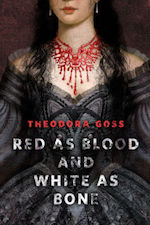 In Theodora Goss’ “Red as Blood and White as Bone”, a young woodcutter’s daughter holds on to the secret knowledge of fairy tales during a life of drudgery and hard work. When a disguised princess turns up in need of help, the girl knows that she’s finally in a tale… but which one? The short story pulls princes and princesses, shapeshifting wolves, and Baba Yaga herself out of their respective forests and deftly weaves them into 20th century Europe, which of course holds far greater monsters than any folktale.
In Theodora Goss’ “Red as Blood and White as Bone”, a young woodcutter’s daughter holds on to the secret knowledge of fairy tales during a life of drudgery and hard work. When a disguised princess turns up in need of help, the girl knows that she’s finally in a tale… but which one? The short story pulls princes and princesses, shapeshifting wolves, and Baba Yaga herself out of their respective forests and deftly weaves them into 20th century Europe, which of course holds far greater monsters than any folktale.
A Tor.com Original, you can read the story here in our archives.
The Bear and the Nightingale by Katherine Arden
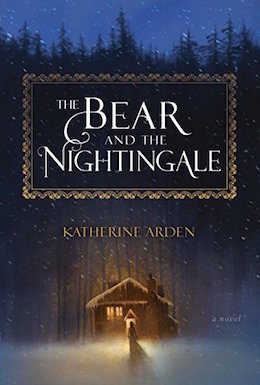 Young Vasilisa Petrovna, raised on her nurses tales of rusalka and Frost Demons, has no wish to marry, but her stepmother wants the daughters of the household either wed or sent to convents (the better to break them of their devotion to household spirits, and bind them to God) and the village’s new priest urges his flock to see the old ways as demonic.
Young Vasilisa Petrovna, raised on her nurses tales of rusalka and Frost Demons, has no wish to marry, but her stepmother wants the daughters of the household either wed or sent to convents (the better to break them of their devotion to household spirits, and bind them to God) and the village’s new priest urges his flock to see the old ways as demonic.
Luckily for Vasya, the sprites want to help her, and warn her to beware the dead, stay in her home forest, and especially to defend against the great Bear that is gaining strength in the shadows. As a terrible winter storm rages, and the village nears starvation, Vasya must ignore the wishes of father, stepmother, and priest to embrace her own power, and seek the help of creatures from deepest folklore to help in her fight against the Bear. The Bear and the Nightingale, the debut novel of Katherine Arden, will be available for your fairy-tale-loving brains on January 17th, 2017.
These are some of the best updates on Russian lore—what are your favorite fairy tale adaptations?










